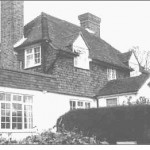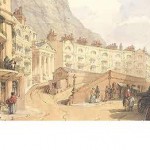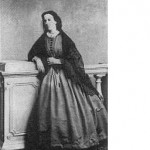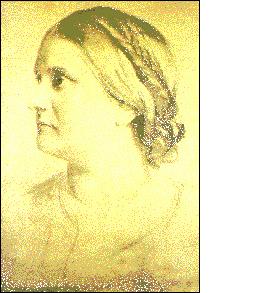The Hastings Connections
By Helena Wojtezak
Barbara Leigh Smith Bodichon (1827-91) was one of the founders of the women’s rights movement in Britain. She was born in Whatlington, near Battle, Sussex, died at nearby Robertsbridge, and was connected to the Hastings area throughout her life.

Barbara’s father, Benjamin Leigh Smith, was an MP’s eldest son. One of his four sisters married into the Nightingale family and produced a daughter, Florence; another married into the Bonham-Carter family. Smith’s home was 5 Blandford Square, Marylebone, London, but from 1816 he inherited and purchased property near Hastings: Brown’s Farm near Robertsbridge, with a house built around 1700 (extant), and Crowham Manor, Westfield, which included 200 acres. Although a member of the landed gentry, Smith held radical views. He was a Dissenter, a Unitarian, a supporter of Free Trade, and a benefactor to the poor. In 1826 he bore the cost of building a school for the inner city poor at Vincent Square, Westminster, and paid a penny a week towards the fees for each child, the same amount as paid by their parents.
Ben’s father wanted him to marry Mary Shore, the sister of William Nightingale, an in-law by marriage; however, on a visit to his sister in Derbyshire in 1826 Smith met Anne Longden, a 25-year-old milliner from Alfreton. She became pregnant and Smith took her to a rented lodge at Whatlington, a small village in Sussex. There she lived as ‘Mrs Leigh’, the surname of Ben Smith’s relations on the Isle of Wight. The child, Barbara, was born on 8 April 1827. Smith rode on horseback from Brown’s Farm to visit them daily, and within eight weeks Anne was pregnant again. When little Ben was born the four of them went to America for two years, during which time another child was conceived. On their return to Sussex they lived openly together at Brown’s (left), and had two more children. After their last child was born, in 1833, Anne became ill and Smith leased 9 Pelham Crescent, which faced the sea at Hastings; the healthy properties of sea air were highly regarded at the time. A local woman, Hannah Walker, was employed to look after the children. Anne did not recover so Smith took her to Ryde, Isle of Wight, where she died in 1834.

It is something of a mystery that the couple never wed. The scandal of marrying a woman from a lower social class was nothing compared with raising five children out of wedlock. Biographer Pam Hirsch feels that perhaps Smith did not want Anne and the children to become his chattels,as the law would have deemed them had the pair married. This would certainly have fitted in with Smith’s radical beliefs and later actions. In 1836, when Barbara was nine, Smith and the five children settled permanently into 9 Pelham Crescent. Smith was elected MP for Norwich and while at the House of Commons, he asked Aunt Dolly Longden or Aunt Julia Smith to look after the children. Local people were employed to help: Catherine Spooner, governess; Harry Porter, Latin and history tutor; and Mr Willetts, the foremost local riding master. In 1842 Smith spent £215 on a beautifully ornate, eight-seater omnibus from the best coachbuilders in Hastings, Rock and Baxter of 6 Stratford Place, West Parade. With coachman Stephen Elliott at the reins, four horses drew the magnificent vehicle carrying the Leigh Smith children and their staff around Sussex and the home counties.

During the 1840s Benjamin Smith bought more land to the south and west of Robertsbridge, including Scalands Farm (extant), Mountfield Park Farm (extant) and Glottenham Manor (rebuilt and now a nursing home). The latter included the ruins of a 14th-century fortified and moated house. When each of his children reached 21, Smith broke with tradition and custom by treating his daughters the same as his sons, giving them investments which brought each an annual income of £300. He also gave to Barbara the deeds of the Westminster school.
The combination of an unconventional upbringing and a private income placed Barbara in an extraordinary position for a mid-Victorian woman. Whereas most women were raised to be obedient and expected only to marry, bear children and live in subordination to a husband, Barbara was free to live her life almost as she pleased. Money could not buy everything, however; for example her brother Ben went to Jesus College Cambridge in 1848, but Barbara was denied such academic opportunities, since no university would admit women. But she did not succumb to housewifery; she became a painter and social reformer. Despite her wealth Barbara eschewed high society and allied herself with the bohemian, the artistic, and the downtrodden.
Despite having illegitimate children, Benjamin Smith was highly regarded and he became a magistrate in Hastings in 1845 after retiring from Parliament. His children were accepted by Hastings society and during her seventeen years at Pelham Crescent Barbara became acquainted with many notable people. In 1846 she met her best friend Bessie Rayner Parkes, when Bessie’s father hired rooms from Smith at 6 Pelham Crescent. In Hastings Barbara also met Anna Howitt and her children; Eliza Fox Bridell; Gertrude Jekyll; Marianne North, whose father was one of the two Hastings’ MPs; Miss Bayley of 2 Holloway Place; and Ann Samworth and her children, who lived at Brook lands Cottage, Holloway place, Old London road.
The three Samworth girls and the three Leigh Smith girls enjoyed painting expeditions around Hastings. Barbara studied art at Bedford Square Ladies College (London) during 1849 and gained some renown as a painter. Some of her work is held at Hastings Museum; other paintings are at Girton College, Cambridge. The Hastings & St Leonards Observer wrote (in 1891) of her paintings:
Among the canvasses the scenes of Algerian landscapes are such that only a born artist would dare to paint. The most vivid colours are dashed about in wonderful profusion, and such a critic as Ruskin has spoken in terms of high praise of her clever work.
In the art world Barbara met the painter William Hunt, who lived during the winter in a small house at the foot of the East Cliff, Hastings. Barbara’s painting tutors included W. Collingwood Smith, who took her to meet John Hornby Maw in West Hill House. Through Miss Bayley she met George Scharf, later director of the National Portrait Gallery. Through the Howitts she met Elizabeth Barrett Browning, Anna Jameson, Adelaide Procter and William Johnson Fox, the Unitarian minister. In 1852 she met George Eliot, who was to remain a lifelong friend.
As well as art, Barbara studied political economy and law at Bedford Square. Another lifelong friend was William Ransom (b.1822), a printer and stationer based at 42 George Street, Hastings. He gave her the opportunity to get her radical ideas into print by allowing her to write women’s emancipation articles for his newspaper, the Hastings & St Leonards News. From June to August 1848 Barbara wrote, under the pen-name ‘Esculapius’, An Appeal to the Inhabitants of Hastings, Conformity to Custom and The Education of Women.
In 1850 Bessie Parkes introduced Barbara to her cousin, the first woman physician, Dr. Elizabeth Blackwell. However, Barbara’s cousin Florence Nightingale snubbed her Uncle Ben’s illegitimate offspring.

As young women of 21 and 23, Bessie and Barbara were, most unusually, allowed to go unchaperoned on a walking tour of Belgium, Germany, Switzerland, Austria, visiting Mary Howitt in Munich. The three discussed women’s inferior status and wanted to change it. But men held all political power and would fight to preserve the system which served their interests so well. The two did, however, indulge in a little personal liberation. Female costume at the time was uncomfortable, impractical and restrictive. They abandoned their corsets and shortened their skirts, prompting Barbara to pen the lines:
Oh! Isn’t it jolly
To cast away folly
And cut all one’s clothes a peg shorter
(A good many pegs)
And rejoice in one’s legs
Like a free-minded Albion’s daughter.
They were also, rather audaciously, swanning around in heavy boots and wearing blue tinted spectacles!
From the early 1850s Barbara divided her life between Hastings and London. The opening of the railway line to London in 1851 shortened her journeys to just 2 1/2 hours. Prior to this, the journey took 8 hours, either by road, or by road and rail via Staplehurst Station.
Willie Leigh Smith became estates manager at Glottenham and Ben was training to be a barrister so in 1853 their father gave up Pelham Crescent. Smith and Barbara lived at Blandford Square or in Sussex, staying often at Scalands Farm. While in the Hastings area Barbara continued to spend time among artists and bohemians. Among her friends were members of the Pre-Raphaelite Brotherhood including Rossetti and Siddal. It was she who arranged convalescent accommodation for Lizzie Siddal at 5 High Street in 1854.
“Rye’s Own” May 2008
All articles, photographs and drawings on this web site are World Copyright Protected. No reproduction for publication without prior arrangement
